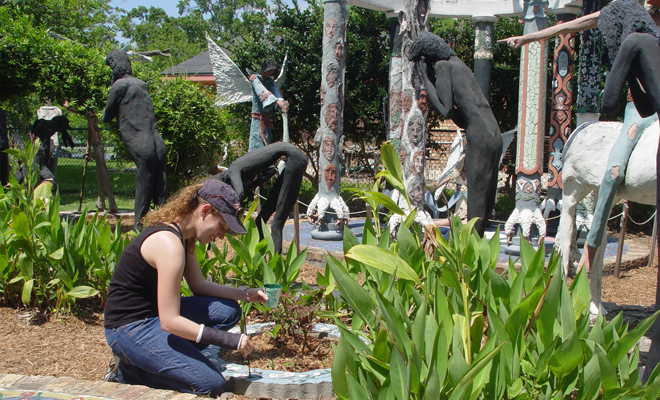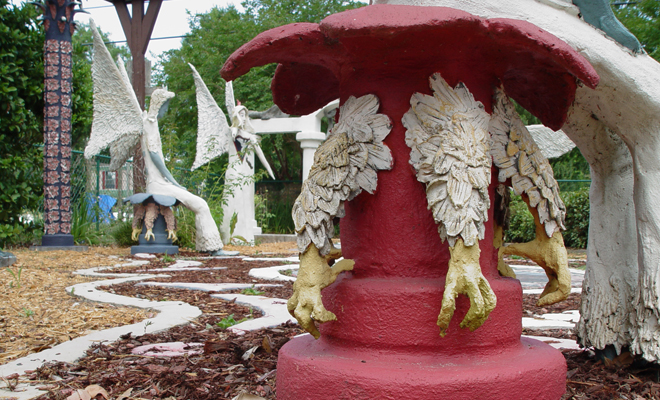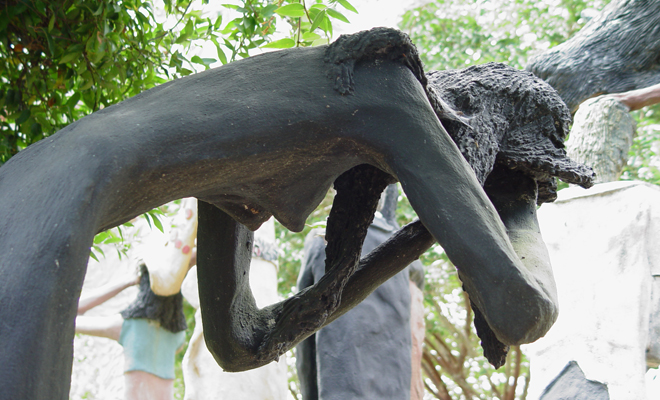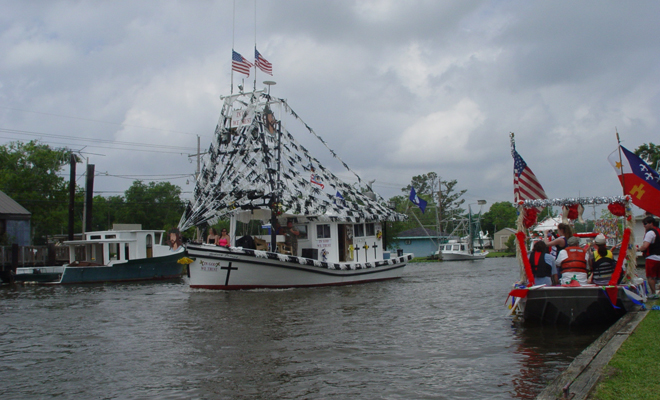Blessings, Beer & Purgatory: Chauvin’s Folk Art Festival & Blessing of the Fleet

Students and volunteers conduct tours and help with upkeep at the university’s art studio and sculpture garden.
Shrimp boats and trawlers decked with crepe and plastic flags line Petit Caillou bayou. Families have been up since early morning to decorate the boats in themes ranging from rock ’n’ roll to the LSU Tigers. Up and down the slim channel, friends are gathered in bars, backyards, and boat garages to drink beer and cook out. In front of St. Joseph Church, which fronts the bayou, a bishop wearing flowing white robes, sunglasses, and a captain’s hat prepares to dab holy water on the town’s shrimping boats, to bless them before the upcoming May season.
A couple miles down Petit Caillou, plastic flowers and tinsel festoon a motorboat in Nicholls State University’s trademark red and white. A pair of scuffed white fishing boots, belonging to Nicholls biologist Gary LaFleur, hang over the helm. Nicholls’ main campus is in Thibodaux but Chauvin houses the university’s art studio and sculpture garden. The art studio is hosting a festival and picnic on this April Sunday to coincide with the town’s traditional blessing of the fleet.
“We do our picnic [during] the blessing of the fleet to show support to Chauvin,” says LaFleur. “The core of the blessing has always seemed to be the way families that fish are supported by the church…Environmental catastrophes and hurricanes come and go.”
Chauvin is familiar with these kinds of hardships. The long-declining shrimping business the town depends on has suffered since the 2010 Deepwater Horizon spill. Attorneys advertise help with BP settlements on billboards throughout the area, which is located an hour and a half southwest of New Orleans and close to the spill. Folkways like decorating boats for the blessing have survived because of the continuance of small-scale family shrimping companies, where trawling and knowledge of the region’s precarious wetlands are passed from generation to generation. But in addition to the area’s continuing small-scale family fishing businesses, thanks to Nicholls State, Chauvin has also become a refuge for the region’s folk art.

Over the course of a decade, Kenny Hill, a bricklayer and folk artist, built a lighthouse and sprawling sculpture garden in Chauvin, now part of Nicholls State University.
Nicholls’ art center is located in Chauvin namely because of the unforgettable outdoor sculptures of Kenny Hill, a sort-of drifter Hieronymus Bosch who came to Chauvin in the late ’80s after a failed marriage. Squatting on the bayou until 2000, Hill slowly constructed a wending path through hell, purgatory, limbo, and heaven populated by human-size angels and penitents. LaFleur first became aware of Hill’s art in the ’90s, cruising down the bayou to conduct fieldwork on the egg-laying habits of female frogs and fish. He could see the 45-foot-high tower of a lighthouse protruding from the grasses and banana trees that overgrew the shore. Over the course of a decade, Hill, a bricklayer by trade, built the lighthouse on the edge of the bayou with a sprawling sculptural garden to surround it. The lighthouse remains the heart of Hill’s work. Row after row of concentric rings of 7,000 bricks form the lighthouse tower. Its surface is covered with characters built from quick dry cement: cowboys and Indians, angels, God and a lamb, the soldiers from Iwo Jima, a jazz band, an airplane, and a flotilla boat swirl toward the sky.

Gaunt figures with charred black skin and bowed heads are part of Hill's intricate personal visual language.
At the head of the garden path that wends from the main road to the lighthouse stands a statue of Hill himself, a gaunt man with torn jeans and a scraggly blond beard. He holds a baseball cap over his heart, from which red paint spills. He stands in front of a white gate guarded by ash-shaded lost souls with rebar wings. Inside, an eagle lifts off from a pedestal. Demonic angels with robes and black fishing boots guard the four-foot-high red flame of hell. On the other side of the garden, figures with charred black skin and bowed heads walk a crooked path but slowly give way to figures in full color—a crawling baby, a general, an elderly couple—being guided forward by angels who hover and lift, sometimes only attached to the other figures at a few points. All the figures are the size of real humans but more emaciated, their forms lean, with exaggerated and chiseled contours. Elsewhere, Christ drags a driftwood cross with a rusty chain and anchor trailing behind. A weeping angel with long outstretched wings holds an hourglass made from hot-sauce bottles with a crucifix at the bottom.
Not only is the installation full of different portals and stations, but it is the product of Hill’s intricate personal symbolic language. Eagles and roses twine the figures and the paths. Holy flame shoots from the head of angels. Throughout the garden, a circle with nine dots in it recurs: it’s an aerial view of the garden’s nine different sections.
To work on his art, Hill picked up money from sporadic brick-laying gigs for locals. He would buy quick dry cement, one two-dollar bag at a time, from Chauvin’s lumberyard. Residents left him alone but were vaguely aware that he was creating something in the tangle of foliage where he camped on the bayou. They placed cans of paint left over from boating and house projects at the edge of the road for him. But then the landowner who’d been letting him squat died. When his children served Hill eviction papers for uncut grass, he snapped the head off the Christ figure and left town without a word to anyone. One of the stations remains unfinished: the penitents process toward an empty concrete platform with holes to support more figures dug into it—perhaps intended as a judgment scene. Hill was later traced to his brother’s in Russellville, Arkansas, but has never returned to Chauvin. Gary LaFleur and Dennis Siporski, a sculpture professor also aware of the garden, saved Hill’s work by acquiring the land for Nicholls State in 2002.
Slowly, their efforts have caused ripple effects in the community. Dot-tee Ratliff, a Chauvin folk artist, became inspired to work on her own art after meeting the professors restoring the garden. Inspired by the sculpture garden and encouraged by Siporski, Ratliff, a retired preschool teacher, began painting the Touloulou crabs that harassed her when she planted Texas bluebonnets in the garden of a local community college. Painting crabs and armadillos on glass panels, she discovered a latent gift. She worried her work was too simple. Siporski said her work was unique and encouraged her to go onto canvas. He told her to go into her studio, shut the door, and paint what was in her heart. She began to construct frames from the cypress branches that floated into her yard during Hurricane Ike and to paint a series of pink alligators enacting scenes from her childhood. Ratliff, who adopted the Cajun-phonetic spelling of ”Dot-tee” when she began to show and sell outside Terrebonne Parish, now displays her work monthly at the Freret Street market and has sold to collectors from Connecticut to Washington State. It didn’t occur to Ratliff how fragile her childhood world was until, during the oil spill, someone visiting her studio looked at the pink alligator series and said, “you know, you’re painting history.” Ratliff is 60 years old and her art connects her to Chauvin’s rich past, a world of blackberry picking, crab boils, thickets of palmetto, and weekends at the now-defunct shrimp platform at Lake Barry. The conch her grandfather blew when a ship approached the drawbridge.
When Ratliff was a teenager, 50 vessels in full decoration paraded down the bayou during the blessing of the fleet (it’s now closer to a dozen). She remembers her aunt bent over her black Singer sewing machine months in advance, turning out cotton flags for the blessing, “every one a different color.” Ratliff drew designs for the boat decorations, often on religious or pop culture themes, like Mickey Mouse. The creation of decorations back then was secretive and deeply competitive, with the decorations only unveiled at the blessing itself. At that time, mass was given at a Catholic church on the side of the bayou and near a shrimp factory (neither church nor factory exists anymore). She modestly hid her swimsuit under a dress while the priest was present. After the blessing, then and today, the boats arrive at Lake Boudreaux (said “boo-dree”) for an afternoon and evening of beer and swimming. She remembers how she and her friends would drop their clothes upon reaching the lake and “just jump off the boats.”
“That was the first sunburn of the season,” she says, sitting by the bayou on a bench near Hill’s lighthouse. It’s a bright, warm day. Cumulus clouds rise up into the blue sky. “It’s always the same weather for some reason,” she says. “It’s always a southeast wind.”
While families picnic, tour guides escort visitors through Hill’s garden, explaining the symbols and details of his biography. The studio building houses some of Hill’s possessions from his camp—weathered family photos, a copy of the bible with herbs and flowers pressed in the pages. At the building’s exhibition space, the festival marks the opening of a simple, affecting photography exhibition called “Why Save Coastal Louisiana?” In it, coastal residents hold handwritten signs showing their answer to the question. An older white man with a sunburnt face and a Marine Corps cap holds one that says, “For our Next Generation!” while a young black boy’s reads, “to be safe from hurricanes.”
Outside, near the bayou, professors and locals stand in a circle. Gary LaFleur proffers champagne and cider to ignite a round of toasting for Nicholls’ folk art center. (The traditional Cajun toast is “Salut.”)
Dot-tee Ratliff raises her glass to Gary and Dennis. “Thank you for making my community special—so when we go somewhere, we can say, ‘We have art in Chauvin!’”
“Salut!”
Up the bayou, the bishop makes his way across the grass near St. Joseph Church to deliver mass. At a nearby house, a large group of family and friends blasts the FM country station, drinks beers, and walks on and off a large trawler, decorated with handmade crepe-paper guitars, LPs, and lightning bolts. On the stern, paper letters read “ELVIS HAS LEFT THE BAYOU.” A small motorboat makes its way up the bayou carrying girls in bikinis and a woman with a pan of crawfish on her lap.
In Chauvin, the line between art and life can be thin and fluid. The sensual and the sacred mingle. Livelihood is tied to stewardship of the wetlands. Ghosts take the form of pink alligators, and redemption rises from rebar and quick dry cement. In Chauvin, art flourishes in the most unexpected ways.

The boats begin their procession during the annual blessing of the fleet in Chauvin, held this year on April 15.
Editor's Note
The Chauvin Sculpture Garden is open daily from dawn to dusk. The Nicholls State University Art Studio (5337 Bayouside Drive in Chauvin) is open Saturday and Sunday from 11 am to 4 pm, with guided tours of the garden available by request.



